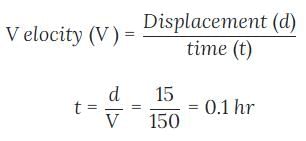Important Questions Test: Motion & Time - UPSC MCQ
10 Questions MCQ Test - Important Questions Test: Motion & Time
The distance-time graph of the non-uniform motion is a _________ line
Which of the following is an example of non-uniform motion?
A scooterist travels at 30 km/h along a straight path for 20 minutes. What is the distance traveled?
Rajdhini express moves at a speed of 150 km/h. How long will it take to cover a distance of 15 km?
Which of the following does not express a time interval?
If we denote speed by S distance by D and time by T the relationship these equation is?
A train travels at a speed of 60 km/h. How far will it travel in 4 hours?
The meter that is used to measure the distance moved by the vehicle is known as _____. Fill in the blank.
Car travels first 60 km of a distance in 1 hr, next 70 km of the distance in next hour and remaining 20 km distance in final hour. Find its type of motion
What is the speed of a car that travels 15 km in 20 minutes, expressed in km/h?



















